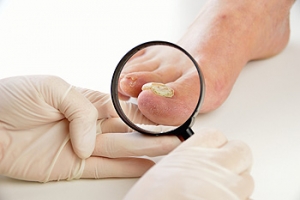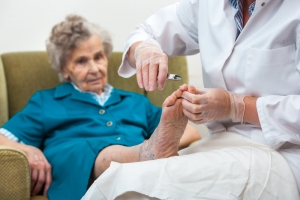
What Is the Medical Term for Toenail Fungus?
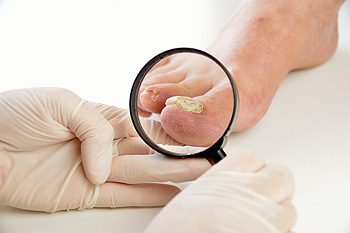 A common foot ailment that many patients suffer from is known as toenail fungus. The medical term for this contagious condition is referred to as “onychomycosis”. There are several noticeable symptoms that are associated with toenail fungus including thickening of the nail, discoloration, and cracking. Diabetic patients may be more susceptible, due to a weakened immune system. Additionally, if there has been an injury that has happened to the nail, or if circulation problems exist, these conditions may lead to the development of toenail fungus. Research has indicated that there are methods that can be implemented which may help to prevent this condition from occurring. These can include wearing appropriate shoes while in public swimming pools and surrounding areas, avoiding sharing nail clippers, and keeping the feet clean and dry. If you have this ailment, please consult with a podiatrist who can offer the proper treatment solutions.
A common foot ailment that many patients suffer from is known as toenail fungus. The medical term for this contagious condition is referred to as “onychomycosis”. There are several noticeable symptoms that are associated with toenail fungus including thickening of the nail, discoloration, and cracking. Diabetic patients may be more susceptible, due to a weakened immune system. Additionally, if there has been an injury that has happened to the nail, or if circulation problems exist, these conditions may lead to the development of toenail fungus. Research has indicated that there are methods that can be implemented which may help to prevent this condition from occurring. These can include wearing appropriate shoes while in public swimming pools and surrounding areas, avoiding sharing nail clippers, and keeping the feet clean and dry. If you have this ailment, please consult with a podiatrist who can offer the proper treatment solutions.
If left untreated, toenail fungus may spread to other toenails, skin, or even fingernails. If you suspect you have toenail fungus it is important to seek treatment right away. For more information about treatment, contact Dr. James Kutchback of James Kutchback, DPM, ABLES, CWS-P. Our doctor can provide the care you need to keep you pain-free and on your feet.
Symptoms
- Warped or oddly shaped nails
- Yellowish nails
- Loose/separated nail
- Buildup of bits and pieces of nail fragments under the nail
- Brittle, broken, thickened nail
Treatment
If self-care strategies and over-the-counter medications does not help your fungus, your podiatrist may give you a prescription drug instead. Even if you find relief from your toenail fungus symptoms, you may experience a repeat infection in the future.
Prevention
In order to prevent getting toenail fungus in the future, you should always make sure to wash your feet with soap and water. After washing, it is important to dry your feet thoroughly especially in between the toes. When trimming your toenails, be sure to trim straight across instead of in a rounded shape. It is crucial not to cover up discolored nails with nail polish because that will prevent your nail from being able to “breathe”.
In some cases, surgical procedure may be needed to remove the toenail fungus. Consult with your podiatrist about the best treatment options for your case of toenail fungus.
If you have any questions, please feel free to contact our offices located in The Woodlands and Woodville, TX . We offer the newest diagnostic and treatment technologies for all your foot care needs.
Toenail Fungus
Toenail fungus is a frustrating problem that affects many people. It can be persistent and hard to get rid of. As many different types of fungi are present throughout the environment, it is very easy to contract toenail fungus.
The feet are especially susceptible to toenail fungus because shoes and socks create the ideal dark and moist environment that fungal infections thrive in. While fungal infections of the nail plate are quite common, if left untreated they can spread beyond the toenail and into the skin and other parts of the body.
Signs of toenail fungus include a thickened nail that has become yellow or brown in color, a foul smell, and debris beneath the nail. The toe may become painful due to the pressure of a thicker nail or the buildup of debris.
Treatment for toenail fungus is most effective during the early stages of an infection. If there is an accumulation of debris beneath the nail plate, an ingrown nail or a more serious infection can occur. While each treatment varies between patients, your podiatrist may prescribe you oral medications, topical liquids and creams, or laser therapy. To determine the best treatment process for you, be sure to visit your podiatrist at the first signs of toenail fungus.
Successful Ways to Properly Care for Children's Feet
 When children’s feet are properly cared for, specific foot problems may be avoided as they get older. One of the first things parents can do for their children is to wash and dry their feet daily, especially between the toes. It is encouraged for toddlers to walk barefoot while indoors, and this may be helpful in strengthening the overall foot as the toes grasp the floor. When children are walking outdoors, it is beneficial to have your child’s feet measured, as this can help in determining that the correct size shoes are purchased. It is important that the toes have adequate room to move freely in, and socks should be made of breathable materials. Additionally, trimming your child’s toenails correctly may prevent ingrown toenails. If you would like more information about how to take care of children's feet, it is suggested that you speak to a podiatrist.
When children’s feet are properly cared for, specific foot problems may be avoided as they get older. One of the first things parents can do for their children is to wash and dry their feet daily, especially between the toes. It is encouraged for toddlers to walk barefoot while indoors, and this may be helpful in strengthening the overall foot as the toes grasp the floor. When children are walking outdoors, it is beneficial to have your child’s feet measured, as this can help in determining that the correct size shoes are purchased. It is important that the toes have adequate room to move freely in, and socks should be made of breathable materials. Additionally, trimming your child’s toenails correctly may prevent ingrown toenails. If you would like more information about how to take care of children's feet, it is suggested that you speak to a podiatrist.
The health of a child’s feet is vital to their overall well-being. If you have any questions regarding foot health, contact Dr. James Kutchback of James Kutchback, DPM, ABLES, CWS-P. Our doctor can provide the care you need to keep you pain-free and on your feet.
Tips for Keeping Children's Feet Healthy
- Make sure their shoes fit properly
- Look for any signs of in-toeing or out-toeing
- Check to see if they have Clubfoot (condition that affects your child’s foot and ankle, twisting the heel and toes inward) which is one of the most common nonmajor birth defects.
- Lightly cover your baby’s feet (Tight covers may keep your baby from moving their feet freely, and could prevent normal development)
- Allow your toddler to go shoeless (Shoes can be restricting for a young child’s foot)
- Cut toenails straight across to avoid ingrown toenails
- Keep your child’s foot clean and dry
- Cover cuts and scrapes. Wash any scratches with soap and water and cover them with a bandage until they’ve healed.
If you have any questions, please feel free to contact our offices located in The Woodlands and Woodville, TX . We offer the newest diagnostic and treatment technologies for all your foot care needs.
What to Do to Keep Your Child’s Feet Healthy
Being a parent involves caring for your child in every way you can. You make sure they are eating the right food, being nice to others, and staying out of any trouble. However, it is also important that you are watchful of their health, more specifically their foot health. Maintaining good foot health in childhood is important in preventing later conditions in life from happening. As children continue to develop, their feet require different techniques of care. Here are some various ways in which you can help your child’s feet stay healthy.
A baby needs a lot of care and attention overall, but the importance of their feet should never be forgotten. Before a baby turns one, their feet change and develop greatly. It is important that during this time, a mother avoids putting tight socks on their child. She should also encourage movement of their feet so the baby can begin to feel more comfortable using them.
As a baby enters the toddler years of his or her life, they are begin to walk around. When your baby begins to take those first steps, it is crucial that they are wearing protective shoes on their feet. As a mother that is observant of your child’s feet, you may notice changes in them. This is completely normal as the feet are becoming susceptible to the activity of walking. It is normal for a toddler to be a bit unsteady or to “walk funny” at first.
When your child grows out of their toddler years, it is important that you begin to show him or her how to care for their feet on their own. Practice with your child proper hygiene in order to prevent foot fungus or infection. Since children are constantly on the move, it is crucial to be cautious of any accidents or injuries that might occur. If an injury occurs, it is advised that you take your child to be examined by a doctor immediately. Since your child is still growing, particular injuries can shift the way in which a bone or other important part of the foot is developing.
Babies and kids are always changing and growing. Your job as a parent is to make sure they stay healthy and making sure they are properly maintained. This involves proper foot care and making sure the feet stay healthy. Following this guide, your child can live a long and happy life.
Foot and Ankle Surgery
When conservative, noninvasive methods prove ineffective, surgery may be selected as the next course of action for the treatment of your foot or ankle condition. A wide number of foot and ankle surgical procedures exist, and it is up to your podiatrist to determine which intervention will be most appropriate and helpful for your case. Some surgical procedures include bunion surgery, fusion, hammertoe surgery, heel spur surgery, metatarsal surgery, nail surgery, neuroma surgery, reconstructive surgery, skin surgery, and tendon surgery. Typically, surgery is turned to as a definitive way to alleviate excessive pain or discomfort and to return your foot to full mobility.
Regardless of the location on the body, all surgical procedures require preoperative testing and examination to ensure the surgery’s success and preferred outcome. A review of your medical history and medical conditions will take place, as will an evaluation of any current diseases, illnesses, allergies, and medications. Tests such as blood studies, urinalyses, EKG, X-rays, and blood flow studies may be ordered. Because the procedure involves the foot and/or ankle, the structures of your feet while walking may also be observed by your podiatrist.
Care post-surgery will depend on the type of surgical procedure performed. Typically, all postoperative care involves rest, ice, compression, and elevation. To improve and ensure a safe recovery, your foot and ankle surgeon may also employ the use of bandages, splints, surgical shoes, casts, crutches, or canes. He will also determine if and when you can bear weight. A timely and thorough recovery is a priority for both you and your podiatrist, and carefully following postoperative instructions can help achieve this.
Can Shockwave Therapy Help Plantar Fasciitis?
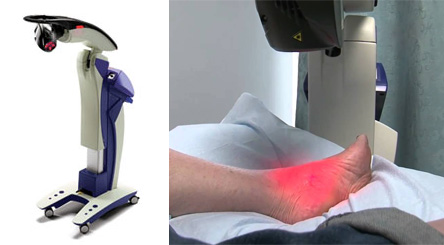 Patients who have chronic foot pain may understand the benefits of receiving shockwave therapy. Shockwave therapy can be helpful in alleviating pain that comes from plantar fasciitis. There are two forms of this type of treatment, and they are known as high and low energy. The former is administered in three or more sessions, which are generally not painful. The latter is often given with a form of anesthesia and can produce severe pain and discomfort. Both forms of this type of treatment use pressurized air or electromagnetic pulses, which may be effective in reducing a portion of chronic foot pain from plantar fasciitis. If you have this type of foot pain, schedule a consultation with your podiatrist to help you determine if this type of treatment is correct for you.
Patients who have chronic foot pain may understand the benefits of receiving shockwave therapy. Shockwave therapy can be helpful in alleviating pain that comes from plantar fasciitis. There are two forms of this type of treatment, and they are known as high and low energy. The former is administered in three or more sessions, which are generally not painful. The latter is often given with a form of anesthesia and can produce severe pain and discomfort. Both forms of this type of treatment use pressurized air or electromagnetic pulses, which may be effective in reducing a portion of chronic foot pain from plantar fasciitis. If you have this type of foot pain, schedule a consultation with your podiatrist to help you determine if this type of treatment is correct for you.
Shockwave therapy is a treatment commonly used to treat various injuries and conditions, particularly plantar fasciitis in the feet. To learn more, consult with Dr. James Kutchback from James Kutchback, DPM, ABLES, CWS-P. Our doctor can provide the care you need to keep you pain-free and on your feet.
Shockwave Therapy
Shockwave therapy is a new treatment option designed to treat bone conditions such as tennis elbow, shoulder pain, and others. Shockwave therapy uses high intensity sound waves that are directed to the affected tissues of the body with pinpoint accuracy. The effects are very beneficial, leading to a production of collagen fibers, eliminating inflammation.
Who Benefits from Shockwave?
Shockwave is recommended for patients suffering from heel pain and associated problems. Heel pain is a common condition which can be caused by obesity, overexertion, and spending a substantial amount of time on hard floors with your feet exposed and unsupported.
Fast and Easy
The therapy is actually a simple process that can leave patients feeling better the very next day. Shockwave therapy is not as dramatic as it sounds. It enables more blood flow to effected areas, addressing the source of the problem and allowing treatment to last for a long time.
Treatment & Recovery Time
Shockwave treatment will enable your feet to recover quickly. This is especially important since surgery is not required. It is cost effective and does not require the use of anesthesia. This treatment is a better option to surgery, since it is proven safe.
If you have any questions, please feel free to contact our offices located in The Woodlands and Woodville, TX . We offer the newest diagnostic and treatment technologies for all your foot and ankle needs.
Shockwave Therapy
Extracorporeal Shockwave Therapy (ESWT) is an alternative treatment method that is used for bone and soft tissue disorders in the foot and ankle. EWST is a noninvasive option for pain relief and it was originally created to help dissolve kidney stones. This therapy works by focusing impulses to target the area in pain. This method has been proven to show a reduction in the amount of nerve fibers that transmit painful impulses, which leads to a reduction in pain. Shockwave therapy can also expedite the tissue which would, in turn, increase the amount of new blood vessels that are formed.
Conditions that can be treated with shockwave therapy include Achilles pain and heel pain. People with plantar fasciitis may opt for this therapy and the results are usually great after 18 months. Additionally, this method can also be used to treat fractures that have failed to heal correctly. Anesthesia is not required to perform this treatment. It usually is not painful, but it can be uncomfortable.
The duration of treatment sessions usually lasts 5-15 minutes each. This procedure is safe since there is no risk of infection from wound complications, if you are looking to try shockwave therapy to heal plantar fasciitis, it may take 3-4 sessions to start working. After treatment, patients typically notice a dull pain in the area which was treated. However, this pain rarely lasts more than 24 hours.
Nevertheless, there are pros and cons that come along with Shockwave Therapy. The most obvious pro is that this treatment is noninvasive, meaning surgery will not be required. Another upside is that there have been very little complications that have been found with this procedure. On the other hand, those who opt for surgery are at risk for continued pain, wound problems, and infections. The biggest con for ESWT is that it is very expensive; it typically costs around $1,000 before insurance. Another con is that the effectiveness of the treatment is questionable. Usually, if this treatment is helpful, the difference is small.
If you are curious about Shockwave Therapy, you should talk to your podiatrist to see if this treatment method is right for you. At times, patients will find that there are other treatment options that are more efficient for their individual cases.
Possible Foot Conditions Among Seniors
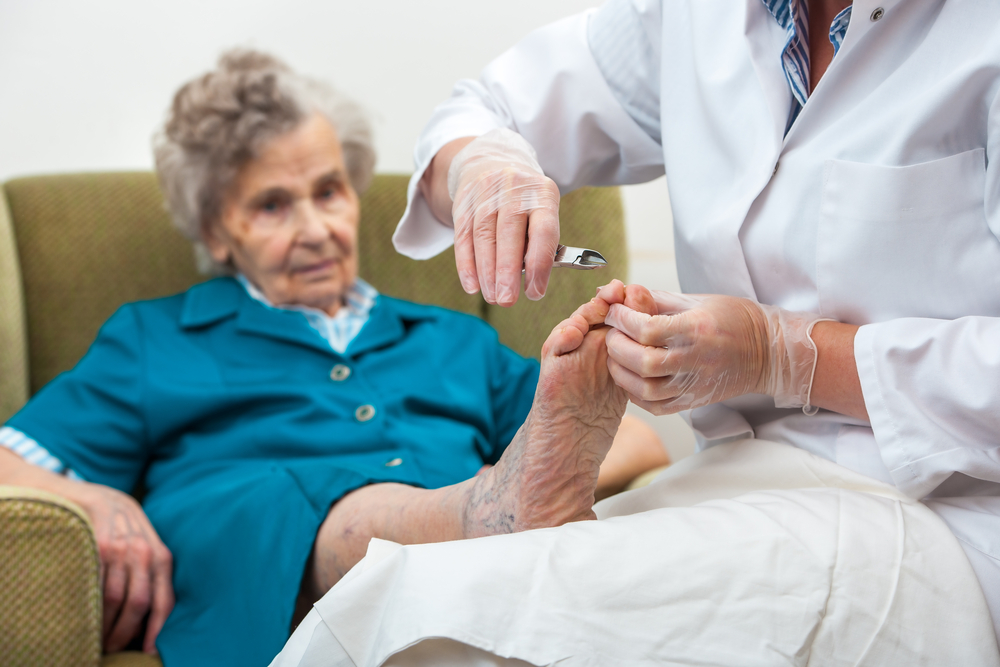 There are many elderly people who experience foot problems as the aging process occurs. It is normal for the nails and skin to become dry and brittle, and this is often the result of a loss of cushioning in the feet. The feet will feel better when shoes that are worn fit properly, which may prevent blisters, corns, and calluses from developing. Poor circulation is a common ailment among seniors, and this can be prevented by quitting smoking, walking daily, and performing gentle stretching techniques. Athlete's foot can cause pain and discomfort, and can easily be prevented. This can be accomplished by changing the socks and shoes daily, wearing appropriate shoes while in public pools and shower areas, and choosing to wear shoes with an open toe as often as possible. If you have questions and concerns about foot conditions for seniors, it is advised to counsel with a podiatrist.
There are many elderly people who experience foot problems as the aging process occurs. It is normal for the nails and skin to become dry and brittle, and this is often the result of a loss of cushioning in the feet. The feet will feel better when shoes that are worn fit properly, which may prevent blisters, corns, and calluses from developing. Poor circulation is a common ailment among seniors, and this can be prevented by quitting smoking, walking daily, and performing gentle stretching techniques. Athlete's foot can cause pain and discomfort, and can easily be prevented. This can be accomplished by changing the socks and shoes daily, wearing appropriate shoes while in public pools and shower areas, and choosing to wear shoes with an open toe as often as possible. If you have questions and concerns about foot conditions for seniors, it is advised to counsel with a podiatrist.
Proper foot care is something many older adults forget to consider. If you have any concerns about your feet and ankles, contact Dr. James Kutchback from James Kutchback, DPM, ABLES, CWS-P. Our doctor can provide the care you need to keep you pain-free and on your feet.
The Elderly and Their Feet
As we age we start to notice many changes in our body, but the elder population may not notice them right away. Medical conditions may prevent the elderly to take notice of their foot health right away. Poor vision is a lead contributor to not taking action for the elderly.
Common Conditions
- Neuropathy – can reduce feeling in the feet and can hide many life-threatening medical conditions.
- Reduced flexibility – prevents the ability of proper toenail trimming, and foot cleaning. If left untreated, it may lead to further medical issues.
- Foot sores – amongst the older population can be serious before they are discovered. Some of the problematic conditions they may face are:
- Gouging toenails affecting nearby toe
- Shoes that don’t fit properly
- Pressure sores
- Loss of circulation in legs & feet
- Edema & swelling of feet and ankles
Susceptible Infections
Diabetes and poor circulation can cause general loss of sensitivity over the years, turning a simple cut into a serious issue.
If you have any questions please feel free to contact our offices located in The Woodlands and Woodville, TX . We offer the newest diagnostic and treatment technologies for all your foot and ankle needs.






